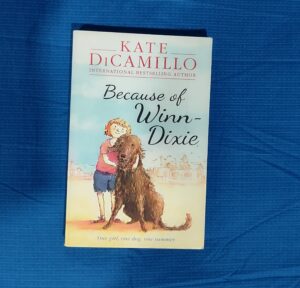
Discover storytelling techniques inspired by ‘Because of Winn-Dixie’—crafting tales with heart, simplicity, and emotional depth.
Kate DiCamillo’s 2000 children’s novel, “Because of Winn-Dixie,” is a heartwarming tale of India Opal and her dog, Winn-Dixie. This simple yet engaging story captivates young readers with its gentle emotional turns and accessible narrative.
The book’s charm lies in its conversational American dialogue and a lean cast of characters, lending a breezy quality to the storytelling. DiCamillo masterfully develops her characters through natural conversations and subtle descriptive touches.
Set against a backdrop of small-town America, the story’s beauty shines in its simplicity.
These are the techniques used to pen this simple yet adorable tale –
- Imparting Lessons Through Atmosphere and Arrangement
A pivotal scene at Gloria Dump’s cottage exemplifies this: trees adorned with colorful crepe paper and candlelit paper bag lanterns transform a humble yard into a magical setting. While party planning can be daunting, “Because of Winn-Dixie” emphasizes the true essence of celebration – togetherness and joy, rather than extravagant displays.
DiCamillo skillfully anchors her narrative within four primary settings: India’s home, the church, the garden, and the library. Through these familiar spaces, she explores complex emotions with remarkable simplicity.
- Symbolism
The story’s genius lies in its ability to translate abstract feelings into tangible sensory experiences, making them accessible to young readers. A prime example is the “litmus lozenge” – a candy that evokes the taste of sorrow:
The librarian shares this unique candy, created by her great-grandfather after losing his family in war. Overwhelmed by grief, he channeled his emotions into confectionery, producing a lozenge that allows each taster to experience melancholy in their own way.
This clever device serves multiple purposes:
- It piques children’s curiosity about the nature of sorrow.
- It introduces the concept of mindful eating, linking food with emotions.
- The story demonstrates how people process and express feelings differently through the symbolic use of Litmus Lozenges – a unique candy with a bittersweet history:
The Candy’s Effect on Different Characters
- When various characters taste the Litmus Lozenges, each experiences their own personal form of sorrow:
- Sweetie Pie instantly recognizes the feeling of longing for a pet
- Amanda is overwhelmed by grief for her drowned brother Carson
- India Opal tastes the absence of her mother
- Miss Franny reveals that sorrow is actually the secret ingredient, explaining how during wartime, people sought these candies specifically to help them access and release their buried grief.
- The Litmus Lozenges serve as a tangible way to experience and understand abstract emotions.
- They demonstrate how taste and memory can be powerfully linked.
- The candy becomes a tool for characters to connect with their deeper feelings.
Opal compares missing her mom to the feeling of probing an empty space with your tongue after losing a tooth. This metaphor effectively captures the experience in a relatable way for the target age group.
Using simple comparisons to interpret complex emotions is a beautiful way to teach children empathy and identify their vulnerabilities.
- The Father-Daughter Dynamic
The dynamic between India Opal and her father (known as “the preacher”) reveals another layer of processing grief:
- When Opal asks about her mother, she carefully observes her father’s physical response (lowered chin, hunched shoulders)
- Opal likens her father to a turtle, noting how he withdraws into himself like a turtle pulling into its shell when the topic of her mother comes up
- This metaphor, seen through a child’s eyes, helps young readers understand how adults might protect themselves from emotional pain
- The scene demonstrates:
- How children can be perceptive to adults’ emotional cues
- The way parent-child relationships can deepen through shared vulnerability
- How being honest about grief, even when difficult, can strengthen family bonds.
Overall, this story is a must-read for children aged seven and up—and an engaging experience for adults. It beautifully explores the inner workings of human emotions, offering a refreshing change from the typical talking animals, folklore, or action-packed adventure tales filling bookstores today.
